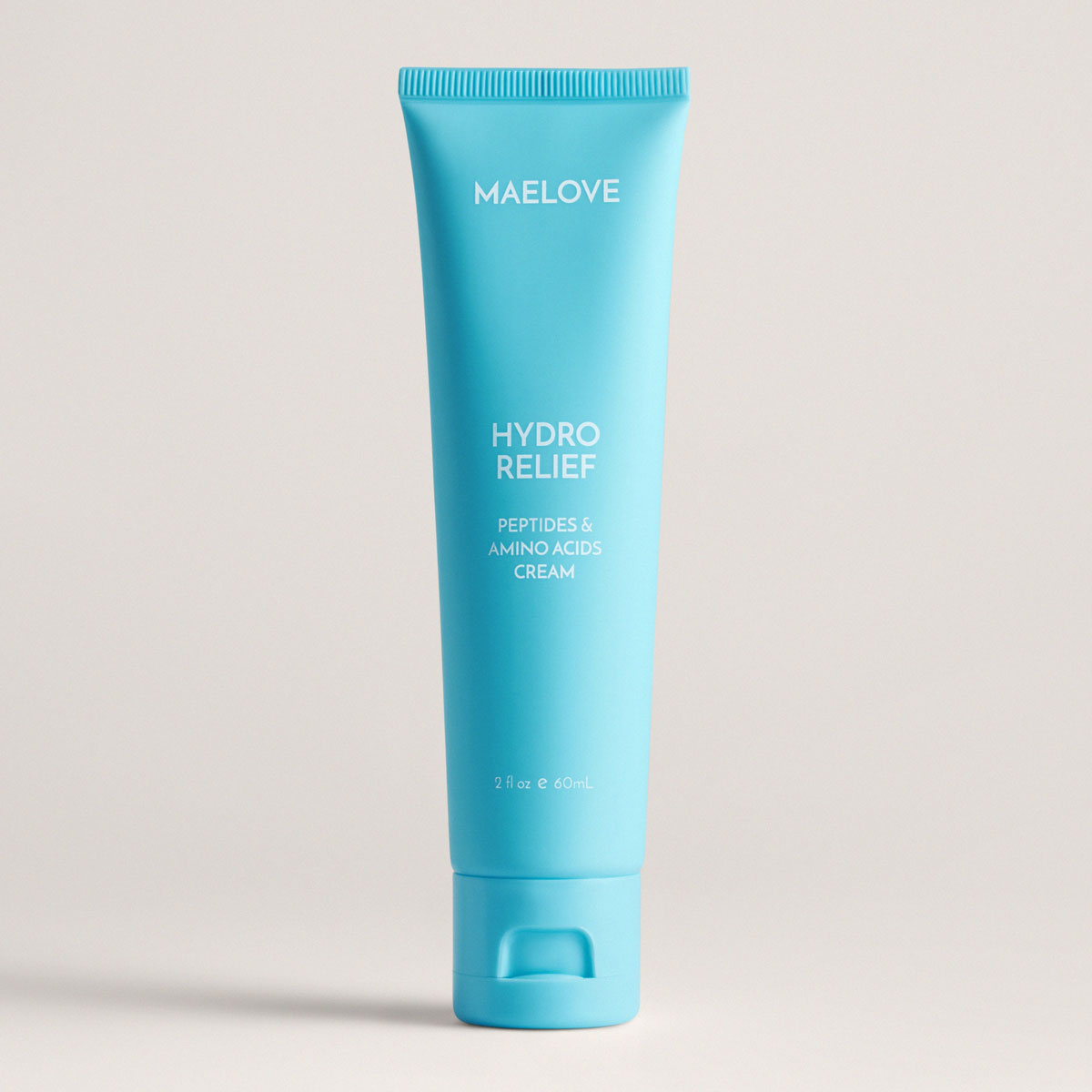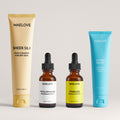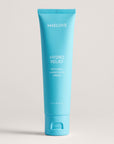

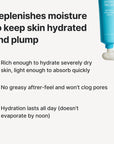
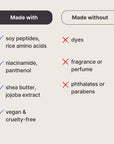
Hydro Relief Peptides & Amino Acids Cream
Hydrating peptides (soy + rice), barrier-strengtheners (niacinamide + panthenol), and moisture-locking lipids (squalane, shea butter, jojoba). Calming antioxidants include green tea and rosemary.*More details can be found in the Ingredients tab lower down in the page.
Use AM and PM. Apply a thin layer to the face, neck, and chest after your serums. Gently massage until fully absorbed.*More details can be found in the How to Use tab lower down in the page.
We ship from our temperature-controlled facility in Northern California, Monday through Friday. US orders over $50 get free shipping.We stand behind our products with a 100-day guarantee. Not happy? Return within 100 days for a full refund. We'll even provide a return shipping labels. No hassle, no hard feelings. We want you to love what you're using, and if it's not working for your skin, we'd rather you find what does.
Peptides and plant-based lipids deeply hydrate and plump the skin
- Rice amino acids and soy peptides replenish moisture levels for a smoother complexion
- Anti-aging properties diminish fine lines and wrinkles for a more youthful appearance
- Squalane, shea butter, and jojoba esters form a protective barrier on the skin to seal in moisture
Vitamins and botanicals manage redness and support the skin barrier
- Niacinamide (vitamin B3) and panthenol (provitamin B5) fortify the skin's barrier and protect against environmental stressors
- Both vitamins have anti-aging and anti-inflammatory properties to calm skin and soothe redness
- Enriched with anti-inflammatory antioxidants green tea and rosemary to further reduce irritation
For AM and/or PM. Apply a thin layer of cream to the face, neck, and chest after serums. Massage product in until it is fully absorbed.
Layer your products from thinnest to thickest in texture, waiting a full minute between each product.
See our How to Layer guide for tips on layering multiple Maelove products.
Key Ingredients
Soy peptides: natural moisturizing factors that are anti-aging
Oryza sativa (rice) bran extract: natural moisturizing factors that help even skin tone
Rice amino acids: natural moisturizing factors
Shea butter: emollient occlusive from nut of African Shea tree
Squalane: plant-derived version of a natural lipid found in skin
Jojoba esters: plant-derived wax from Jojoba shrub with performance on par with slugging
Supporting Ingredients
Niacinamide, panthenol, green tea extract, rosemary extract
All Maelove products are safe for sensitive skin, made in the US, vegan, cruelty-free, non-comedogenic, gluten-free, and free of parabens, phthalates, dyes, and artificial fragrances. We don't use ingredients that are banned in the EU or in the USA.
Show all ingredients
Customer Reviews
For the Curious
When dry skin combines with an arid climate or dry winter weather, it is difficult to keep skin hydrated. While “slugging” with thick petroleum-based products could help keep in moisture, their greasiness makes them unpleasant. After trying many moisturizers, we couldn’t find any that were both deeply hydrating and with that perfect texture and skin-feel. Either they were too thick and goopy, caused milia and acne, were too greasy, or were just too thin and runny to do the job. So we really wanted that combination of perfect texture with high performance. Non-greasy with a smooth finish and non-comedogenic, that absorbed well but still left a good barrier on the skin.
For this reason, the team set to work on a cream that was not only a moisture booster, but also provided a strong barrier that would hold moisture in even in very dry environments, AND had that perfect skin-feel. We also enhanced the formula with skin barrier supporting and redness fighting ingredients that would help keep dry and inflamed skin smooth and calmed.
Amino acids and peptides derived from soy and rice are natural moisturizing factors that also have anti-aging benefits. Incorporating these along with skin barrier supporting vitamins (panthenol and niacinamide) and anti-inflammatory botanicals (green tea and rosemary) into a cream that utilized plant-based lipids (squalane, shea butter, jojoba esters) with performance on par with petroleum provided the solution. The result: A rich, but quick-absorbing, non-greasy cream that feels luxurious but not heavy and can even combat arid climates and dry winter air leaving skin soft, supple, and protected.
Amino acids are the building blocks for proteins and peptides. Peptides are basically mini-proteins. Amino acids and peptide are natural moisturizing factors. Hydro Relief incorporates amino acids and peptides derived from soy and rice that in addition to having hydrating benefits, also provide anti-aging benefits and can even out skin tone.
Amino acids and peptides are hygroscopic molecules (humectants) that play a role as natural moisturizing factors (NMFs) within corneocytes. Indeed, 50% of NMFs are amino acids (from the breakdown of protein filaggrin) while the remaining NMFs are salts such as lactates, urea, and electrolytes (Purnamawati et al. 2017).
Additionally, soy peptides are known as enzyme inhibitor peptides that have anti-aging activity. Studies show soy peptides inhibit serine proteases such as matrix metalloproteinases (MMPs) that break up extracellular matrix proteins such as collagen, elastin and glycosaminoglycans (GAGs) (Schagen 2017, Ferreira 2020). Rice bran extracts and amino acids can also have anti-tyrosinase activity for hyperpigmentation to help even out skin tone (Schagen 2017). Particularly in East Asia, peptides derived from soy and rice have been used for thousands of years going back to ancient times. In modern times, due to these powerfully hydrating, skin tone evening, and anti-aging properties, soy and rice peptides and extracts have been widely used in skincare products in East Asia for decades.
Peptide serums are meant to be contain high potency levels of actives that tackle wrinkles and collagen renewal. In the case of Peptide Squad, this includes therapeutic levels of proven actives from all four classes of wrinkle-fighting peptides including Matrixyl 3000, Argireline, GHK-Cu and rice peptides. In contrast, peptide moisturizers can play a supporting role for anti-aging but the primary function is deep hydration to soothe dry, inflamed skin. In the case of Hydro Relief, this includes soy peptides and rice bran extract and amino acids, that have both anti-aging activity and serve as excellent humectants. However, the plant-based lipids play a crucial role in holding in moisture.
In summer, humectants such as amino acids and peptides can draw in water from the surrounding humid environment, but in the winter when the air is dry, humectants mostly attract water from the underlying dermis which is supplied by blood vessels. Hence, they must be combined with emollients and occlusives so that the water attracted by the humectant does not evaporate but rather is held in by the water-proof barrier forming lipids. The lipids in Hydro Relief are plant-based emollients and occlusives with superior performance (Sethi et al. 2016).
Dry skin in the winter is a common complaint as humidity drops and the skin barrier is insufficient to prevent significant moisture loss. A recent trend called “slugging” uses petroleum jelly (vaseline) to combat winter dryness. However, it is greasy and environmentally unfriendly. Can plant-based lipids form as good a moisture barrier as petroleum-based products but without these downsides? The science says yes and shows plant-based lipids can have other benefits as well.
Shea butter, jojoba esters and squalane are favored to function as emollients and occlusives not only for their natural benefits and functionality but also for superior skin-feel.
Shea butter is a fat extracted from the nut of the African shea tree (Butyrospermum parkii). 85-90% of the fatty acid composition of shea butter is stearic and oleic acids, and the rest is composed of linoleic, palmitic, and arachidic fatty acids. These naturally found long chain saturated fatty acids act not only as occlusives but as emollients, incorporating into the skin barrier and improving skin barrier repair and hydration. In addition to fatty acids, shea butter contains natural triterpenes that have anti-inflammatory action (Purnamawati et al. 2017).
Squalene is a natural component of sebum and one of the most common lipids produced by human skin cells. The amount of squalene produced naturally by the body decreases drastically after age 30 contributing to dry skin with aging. Squalane (with an ‘a’) is a saturated form of squalene derived from plants. Squalane mimics squalene and has the added advantage of being less susceptible to oxidation. This makes squalane an ideal choice for use in moisturizers. Further, it does not have an oily feel, is odorless, does not lead to acne, is antibacterial and is safe for sensitive skin (Sethi et al. 2016).
Jojoba is a shrub native to the Southwestern United States whose seeds contain a liquid wax oil that was first used for skin and hair conditioning and healing by Native Americans. This oil contains long straight-chain wax esters that are more similar in composition to whale oil than other vegetable oils making it a superior occlusive. In fact, in clinical studies, jojoba esters perform on par with petroleum based products at preventing trans-epidermal water loss making it an ideal plant-based alternative for petroleum (Oliphant et al. 2013).
Moisturizers generally provide hydration with humectants, emollients, and occlusives. Humectants attract and hold water, while emollients and occlusives provide lipids that incorporate into your existing skin barrier and also form a film on top of the skin for added water holding support. However, they may also function in a second, more long-term way by promoting the production of endogenous ceramides, cholesterol and fatty acids that form your natural skin barrier. Vitamins, and in particular niacinamide (vitamin B3) and panthenol (provitamin B5) are two of the most proven ingredients that demonstrates this type of skin barrier supporting activity. They have been found to be particularly useful at supporting your skin barrier against winter dryness and reducing redness.
Panthenol is not only an excellent humectant but it is also absorbed into the skin where it is converted into pantothenic acid which is hygroscopic. This is in part why panthenol is an excellent moisturizer. The other is that pantothenic acid is a constituent of coenzyme A which is a cofactor in the synthesis of fatty acids and sphingoplipids that strengthen the skin barrier (Proksh et al. 2017). It is one of the most time-tested ingredients in moisturizers shown in double-blind clinical trials conducted over several decades to be effective and safe at hydrating, repairing and restoring a damaged skin barrier (Proksch et al. 2017, Scott et al. 2022). It is also well tolerated in those with sensitive skin with winter xerosis (Nisbet et al. 2019). Along with niacinamide, panthenol was found to have anti-inflammatory action as well and significantly reduce facial redness due to winter xerosis in those with sensitive skin (Nisbet et al. 2019)
Niacinamide is one of the most well-studied and gold standard ingredients in moisturizers, and particularly in moisturizers that are anti-aging. It directly combats age-related declines in cofactors that are necessary for a strong skin barrier. In other words, it supports the long-term hydration of skin by helping kickstart the body’s natural skin barrier strengthening mechanisms that may have become faulty with aging (Matts et al. 2002). Niacinamide when applied to dry skin has been shown to increase levels of skin barrier lipids such as ceramides, free fatty acids, and cholesterol and to decrease trans-epidermal water loss (Tanno et al. 2008). Niacinamide also increases protein levels for collagen, keratin, fillaggrin, and involucrin which also experience age-related declines (Gehring 2004, Bissett et al. 2006). This is why Niacinamide can also combat fine lines and wrinkles (Bisset et al. 2006).
In addition to its ability to increase skin hydration in older subjects, niacinamide has proven to be an effective and superior ingredient in combating skin dryness in eczema patients and in winter xerosis (dry and scaly skin brought on by dry, winter environments). For instance, in a head-to-head study against white petroleum in the treatment of dry skin in eczema patients, a niacinamide containing moisturizer but not petroleum led to long-term decreases in trans-epidermal water loss across 8 weeks. Further, while skin hydration improved similarly for both the niacinamide containing moisturizer and petroleum immediately after application, superior hydration was seen at 4 weeks and 8 weeks with niacinamide (Soma et al. 2005). Hence, with continued use, a niacinamide containing moisturizer was superior to white petroleum at strengthening the skin barrier and combatting skin dryness long-term. Niacinamide has also been shown to improve hydration and alleviate skin dryness specifically in patients with winter xerosis (Gehring 2004, Nisbet et al. 2019).
Panthenol and niacinamide have additional desirable properties as anti-inflammatories. Modern moisturizers further aim to include additional antioxidant and anti-inflammatory ingredients such as botanical extracts. Dry skin leads to a weakened skin barrier and hence, allergens and microbes can penetrate leading to free radical damage and inflammation. Inflamed and dry skin is therefore a common complaint. The addition of antioxidant and anti-inflammatory ingredients in moisturizers can aid in combating free radical damage and treating the inflammation. Botanical extracts from green tea and rosemary incorporate phytocompounds that have naturally antioxidant and anti-inflammatory action found to be beneficial for skin health (Prasanth et al. 2019, Pomi et al. 2023).
Share details about your shipping policies, item returns, or customer service.
Escobar S, Valois A, Nielsen M, Closs B, Kerob D (2021). “Effectiveness of a formulation containing peptides and vitamin C in treating signs of facial ageing: three clinical studies.” Int J Cosmetic Sci 43: 131-135.
Ferreira MS, Magalhaes MC, Sousa-Lobo JM, Almeida IF (2020). “Trending Anti-Aging Peptides.” Cosmetics 7: 91. Doi:10.3390/cosmetics7040091.
Purnamawati S, Indrastuti N, Danarti R, Saefudin T (2017). “The Role of Moisturizers in Addressing Various Kinds of Dermatitis: A Review.” Clinical Medicine and Research 15(3-4): 75-87.
Schagen SK (2017). “Topical Peptide Treatments with Effective Anti-Aging Results.” Cosmetics 4: 16. Doi:10.3390/cosmetics4020016
Sethi A, Kaur T, Malhotra SK, Gambhir ML (2016). “Moisturizers: The Slippery Road.” Indian J Dermatol 61(3): 279-287.
Purnamawati S, Indrastuti N, Danarti R, Saefudin T (2017). “The Role of Moisturizers in Addressing Various Kinds of Dermatitis: A Review.” Clinical Medicine and Research 15(3-4): 75-87.
Oliphant T. Harper R (2013). “Skin barrier protection with jojoba esters.” JAAD 68 (4) Supplement 1: AB37
Sethi A, Kaur T, Malhotra SK, Gambhir ML (2016). “Moisturizers: The Slippery Road.” Indian J Dermatol 61(3): 279-287.
Bissett DL, Oblong JE, Berge CA (2006). “Niacinamide: A B Vitamin that Improves Aging Facial Skin Appearance.” Dermatologic Surgery 31: 860-866
Gehring W (2004). “Nicotinic acid/ niacinamide and the skin.” J Cosmet Dermatol 3: 88-93.
Matts PJ, Oblong JE, Bissett DL (2002).“A review of the range of effects of niacinamide in human skin.” IFSCC5(4):285-289.
Nisbet SJ, Targett D, Rawlings AV, Qian K, Wang X, Lin CB, Thompson MA, Bulsara PA, Moore DJ (2019). “Clinical and in vitro evaluation of new anti-redness cosmetic products in subjects with winter xerosis and sensitive skin.’ Int J Cosmet Sci 41: 534-547.
Pomi FL, Papa V, Borgia F, Vaccaro M, Allegra A, Cicero N, Gangemi S (2023). “Rosmarinus officinalis and Skin: Antioxidant Activity and Possible Therapeutical Role in Cutaneous Diseases.” Antioxidants 12: 680. Doi.org/10.3390/antiox12030680.
Prasanth MI, Sivamaruthi BS, Chaiyasut C, Tencomnao T (2019). “A Review of the Role of Green Tea (Camellia sinensis) in Antiphotoaging, Stress Resistance, Neuroprotection, and Autophagy.” Nutrients 11: 474. Doi:10.3390/nu11020474.
Proksch E, de Bony R, Trapp S, Boudon S (2017). “Topical use of dexpanthenol: a 70th anniversary article.” J Dermatol Treatment 28(8): 766-773.
Scott LN, Fiume M, Bergfield WF, Belsito DV, Hill RA, Klaassen CD, Liebler DC, Marks Jr JG, Shank RC, Slaga TJ, Snyder PW, Heldreth B (2022). “Safety Assessment of Panthenol, Pantothenic Acid, and Derivatives as Used in Cosmetics.” Int J Toxicol 41(3_suppl): 77-128.
Soma Y, Kashima M, Imaizumi A, Takhama H, Kawakami T, Mizoguchi M (2005). “Moisturizing effects of topical nicotinamide on atopic dry skin.” Int J Dermatol 44: 197-202.
Tanno O, Ota Y, Kitamura N, Katsube T, Inoue S (2008). “Nicotinamide increases biosynthesis of ceramides as well as other stratum corneum lipids to improve the epidermal permeability barrier.” British J Dermatol 143(3): 524-531.

Peptides are the new buzzwords on the face of numerous serums, each claiming transformative benefits. How do you decide if they will do something for you? Let’s unravel the so-called...
